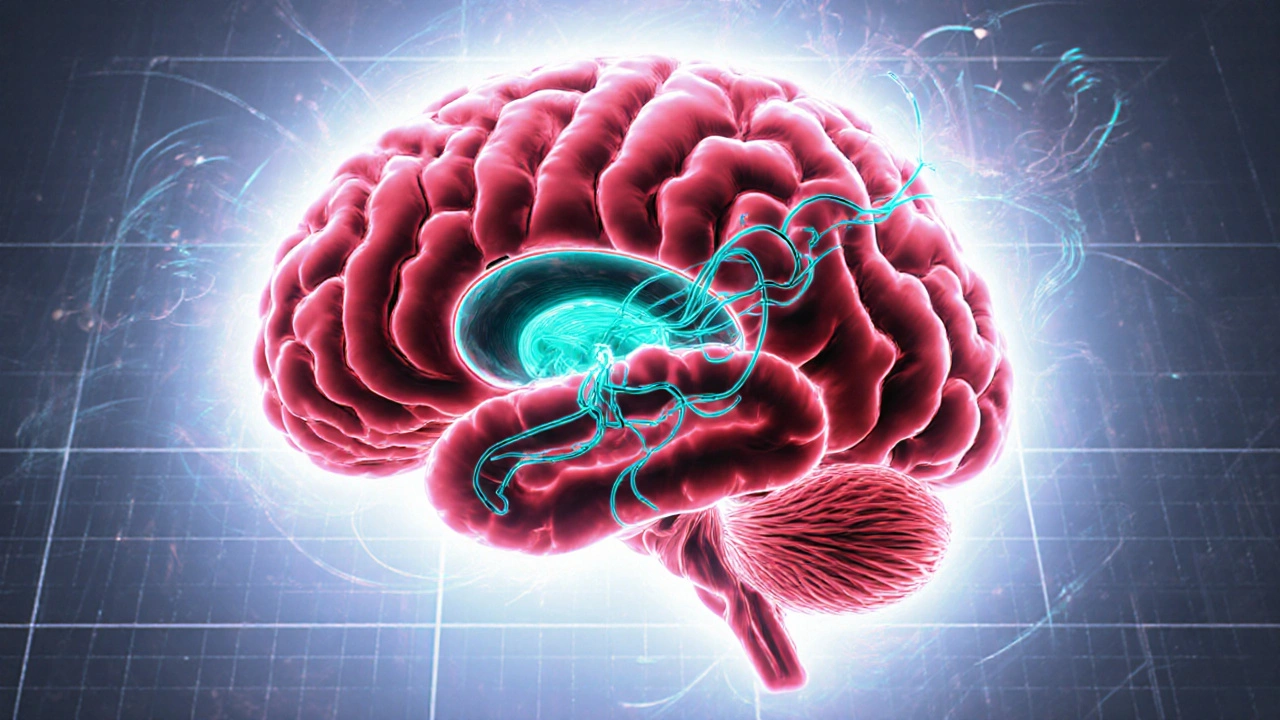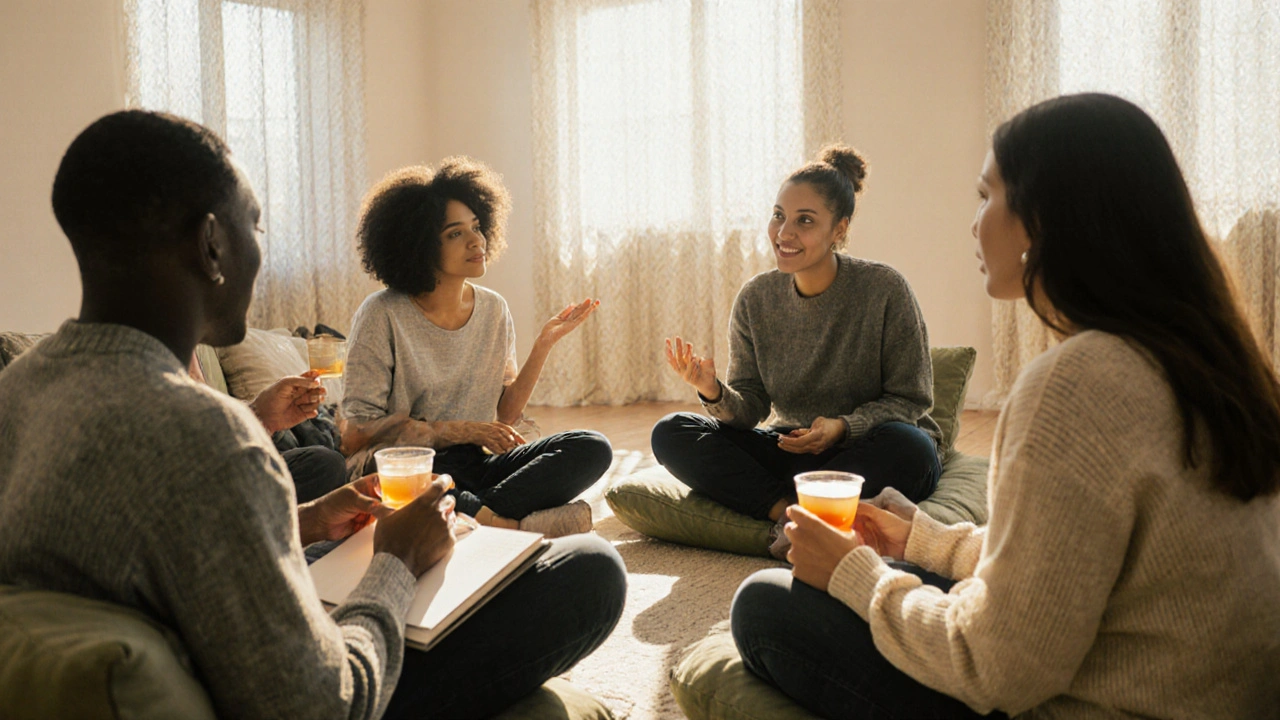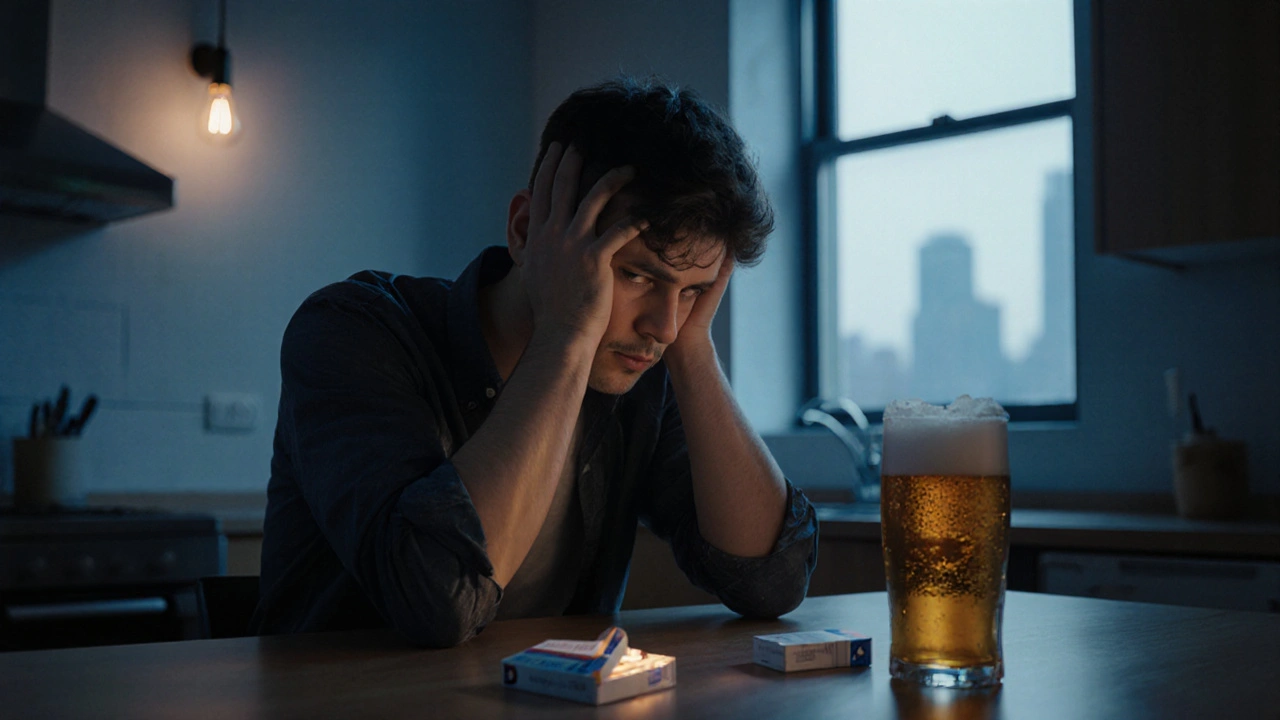Anxiety and Addiction Impact Calculator
Anxiety Severity
Rate your anxiety symptoms on a scale of 1-10 (1 = minimal, 10 = severe):
Substance Use Frequency
How often do you use substances to cope with anxiety? (0 = never, 10 = daily):
Enter values and click "Calculate Impact" to see estimated effects on daily functioning.
When anxiety and addiction appear together, they create a vicious cycle that can trap anyone from a teenager experimenting with alcohol to a professional battling prescription‑opioid misuse. Understanding how these two forces interact helps you break the loop, whether you’re seeking help for yourself, supporting a loved one, or treating patients.
Why Anxiety Often Leads to Substance Use
Anxiety is a feeling of excessive worry, fear, or unease that interferes with daily life. When the brain’s stress system is chronically activated, it craves a quick way to calm the nervous system. Substances like alcohol, benzodiazepines, or nicotine temporarily boost the neurotransmitter GABA, creating a short‑lived sense of relief. This short‑term payoff convinces the mind that the drug is a coping tool, setting the stage for regular use.
- Social drinkers may reach for a beer after a stressful workday to "take the edge off".
- Someone with panic attacks might self‑medicate with fast‑acting benzodiazepines, thinking they’re only using them as needed.
- People with generalized anxiety often turn to nicotine because cigarettes provide an immediate, though brief, calming sensation.
The pattern looks innocuous at first, but repetition rewires the brain’s reward circuitry, turning a coping habit into a habit that the brain expects.
How Addiction Can Heighten Anxiety
Addiction is a chronic, relapsing brain disorder characterized by compulsive drug seeking and use despite harmful consequences. As tolerance builds, the person needs larger doses to achieve the same calming effect. When the substance wears off, withdrawal symptoms-shakiness, heart racing, insomnia-mirror the physical sensations of anxiety, often more intense than the original worry.
Withdrawal creates a feedback loop: the more severe the physical symptoms, the more the individual reaches for the drug to avoid those feelings, which in turn sustains dependence and raises baseline anxiety levels.

Neurobiology: Shared Brain Pathways
Both anxiety and addiction involve the brain’s limbic system, especially the amygdala (fear processing) and the nucleus accumbens (reward). Neurotransmitters such as dopamine, serotonin, and GABA act as messengers in both conditions.
- Dopamine spikes when a drug is taken, reinforcing the behavior, while low dopamine levels are linked to heightened anxiety.
- Serotonin imbalances can lead to mood swings and panic attacks; many antidepressants that raise serotonin also reduce cravings.
- GABA provides inhibitory signals that calm the nervous system; alcohol and benzodiazepines artificially boost GABA, offering temporary anxiety relief but fostering dependence.
Because the same chemicals drive both states, treating one without the other often leaves the underlying imbalance untouched.
Dual Diagnosis: Spotting Both Conditions
Clinicians call the co‑occurrence of mental‑health disorders and substance‑use disorders "dual diagnosis is the simultaneous presence of a mental health condition and a substance use disorder". Detecting dual diagnosis early improves outcomes dramatically.
- Screen for anxiety whenever a patient presents with substance‑use concerns. Tools like the GAD‑7 questionnaire are quick and validated.
- Conversely, ask about substance use when anxiety symptoms dominate a psychiatric evaluation. Even occasional binge drinking can be a red flag.
- Look for overlapping symptoms-sleep disturbances, irritability, and concentration problems often blur the lines.
Ignoring the overlap can lead to treatment failure: a patient may complete a twelve‑step program only to relapse because untreated anxiety resurfaces.
Integrated Treatment Approaches
Effective care blends psychotherapy, medication, and lifestyle changes. Below is a quick comparison of three common integrated models.
| Model | Core Focus | Key Medications | Typical Duration |
|---|---|---|---|
| Medication‑Assisted Therapy (MAT) | Stabilize neurochemical balance while providing counseling | Buprenorphine, Naltrexone, SSRIs for anxiety | 6‑12 months, with taper options |
| Dual‑Focus Cognitive Behavioral Therapy (CBT) | Identify thoughts that trigger substance use and anxiety | Often none; may add low‑dose anxiolytics | 12‑20 weekly sessions |
| Holistic Recovery (Mind‑Body) | Combine meditation, exercise, nutrition with standard care | Vitamin D, Omega‑3s, occasional anti‑anxiety meds | Variable; emphasis on long‑term lifestyle |
Choosing the right model depends on severity, personal preference, and access to resources. A key insight: the best programs treat anxiety and addiction as two sides of the same coin, not as separate problems.

Practical Steps for Individuals
If you recognize the pattern in your own life, try these five actions:
- Track triggers. Keep a simple journal noting moments of heightened anxiety and any substance use that follows.
- Replace the habit. Swap a drink for a brief walk, deep‑breathing exercise, or a glass of water. The goal is a low‑risk coping tool.
- Seek professional screening. A primary‑care doctor can order a brief GAD‑7 assessment and a urine drug screen in one visit.
- Build a support network. Confide in a trusted friend, join a peer‑support group, or engage in an online community focused on dual recovery.
- Consider medication review. Some prescribed drugs (e.g., certain sleep aids) can exacerbate dependence. Ask your clinician about safer alternatives.
Small, consistent changes often outpace dramatic “quit cold turkey” attempts, which can spike anxiety and trigger relapse.
Checklist for Healthcare Providers
To streamline dual‑diagnosis care, use this quick reference:
- Screen every patient for both anxiety (GAD‑7) and substance use (AUDIT‑C) at intake.
- Document overlapping symptoms such as sleep loss, irritability, or muscle tension.
- Offer evidence‑based meds that address both conditions (e.g., SSRIs for anxiety plus buprenorphine for opioid use).
- Coordinate referrals to psychologists trained in dual‑focus CBT.
- Schedule follow‑ups within two weeks of any medication change to monitor anxiety spikes.
When providers treat the pair together, patients report higher satisfaction and lower relapse rates.
Frequently Asked Questions
Can anxiety cause someone to become addicted to caffeine?
Yes. Caffeine stimulates the central nervous system, giving a temporary lift in alertness that many people use to counteract anxiety‑related fatigue. Over time, tolerance builds, and the individual may need more cups to achieve the same effect, creating a mild dependence.
Is it safe to treat anxiety with anti‑depressants while undergoing detox?
Generally, yes, but it requires close monitoring. SSRIs can reduce anxiety without the abuse potential of benzodiazepines. However, some patients experience heightened agitation during early detox, so dosage adjustments may be needed.
What’s the difference between a “craving” and ordinary stress?
A craving is a strong, often intrusive urge driven by the brain’s reward pathways-think of it as a “need” rather than a “want.” Stress can feel uncomfortable, but it doesn’t usually command the same compulsive behavior that a craving triggers.
Do mindfulness apps help with both anxiety and substance use?
Research from 2023 shows that regular mindfulness practice reduces GAD‑7 scores by about 30% and lowers self‑reported craving intensity by roughly 20%. Apps can be a useful adjunct, especially when paired with professional therapy.
How long does it typically take for anxiety symptoms to improve after quitting alcohol?
Most people notice a reduction in physical anxiety (e.g., shaking, heart racing) within two to four weeks of sobriety. Psychological anxiety often continues to improve over three to six months as the brain recalibrates its GABA system.

Kitty Lorentz
October 6, 2025 AT 16:11I really feel you when you say the cycle feels endless its scary and lonely but you’re not alone keep tracking those moments and you’ll catch the patterns.
inas raman
October 11, 2025 AT 07:18Totally get that vibe-when the anxiety‑addiction loop feels tight, simple grounding tricks can actually loosen it. Try swapping one drink for a short walk or a breathing exercise; the body learns a new cue without the chemical crash.
Jenny Newell
October 15, 2025 AT 22:24The neurochemical overlap you described is accurate, yet the piece could benefit from more discussion on allostatic load and its implications for long‑term relapse risk.
Kevin Zac
October 20, 2025 AT 13:31Good point on allostatic load; integrating stress‑inoculation training alongside MAT can attenuate that load, giving patients a neuro‑behavioral buffer against relapse.
Stephanie Pineda
October 25, 2025 AT 04:38When we stare at the mirror of our own mind, the reflection often shows not just anxiety and addiction, but the silent pact we’ve signed with ourselves for temporary peace. That pact, however, is built on sand; each sip, each puff, each pill is a grain that erodes the foundation of genuine calm. In the grand theater of the brain, dopamine takes center stage, flashing the lights for reward, while GABA whispers promises of quiet. The audience, however, is our rational self, coughing out questions that rarely get answered. Over time, the script rewrites itself, substituting wholesome coping mechanisms with chemically‑induced relief. This substitution feels like a shortcut, but shortcuts become dead‑ends when the detour widens into a highway of dependence. Imagine trying to fix a leaky roof with a paper towel; it works for a moment, then the water finds another way in. The same applies to our coping strategies: quick fixes breed chronic vulnerabilities. One practical step is to journal not just the what, but the why-what triggered the urge, what feeling hovered beneath, what belief whispered “you need this now”. Journaling creates a mental map, a cartography of triggers that can be referenced later when the storm clouds gather. Another layer is community; sharing a story in a support group can recalibrate the brain’s reward system away from solitary indulgence. It’s also worth noting that certain medications, like low‑dose buprenorphine, can act as a bridge, smoothing the withdrawal peaks while we rebuild healthier habits. Yet medication alone is a scaffold, not the house; therapy, movement, nutrition, and sleep are the bricks that give it permanence. In short, breaking the loop requires a multi‑dimensional approach-one that honors the chemistry but also the narrative we tell ourselves about control and comfort. So, when the next craving knocks, ask yourself what story you’re trying to rewrite, and choose the chapter that leads to lasting resilience.
Anne Snyder
October 29, 2025 AT 19:44Love that you highlighted journaling and community; adding a quick five‑minute body scan before bedtime can also flag the subtle rise in tension before it spirals.
Rebecca M
November 3, 2025 AT 10:51It is important to emphasize that consistent sleep hygiene can dramatically reduce baseline anxiety levels, thereby decreasing the reliance on pharmacological crutches; maintaining a regular bedtime, limiting blue‑light exposure, and incorporating relaxation techniques are evidence‑based strategies that complement any dual‑diagnosis treatment plan.
Bianca Fernández Rodríguez
November 8, 2025 AT 01:58But honestly, all that “sleep hygiene” talk is overrated – most people who are deep in the cycle can’t even stick to a bedtime, so focusing on that feels like putting a band‑aid on a broken pipe.
Patrick Culliton
November 12, 2025 AT 17:04Exactly, the real issue is that the system pushes quick fixes while ignoring the socioeconomic stressors that seed both anxiety and substance use; until policies address housing insecurity and job instability, any advice about bedtime is just empty rhetoric.
Andrea Smith
November 17, 2025 AT 08:11While acknowledging systemic challenges, it remains essential to empower individuals with actionable resources; the integration of evidence‑based therapies, such as dialectical behavior therapy in conjunction with medication‑assisted treatment, has consistently demonstrated improved outcomes in dual‑diagnosis populations.
Gary O'Connor
November 21, 2025 AT 23:18Yeah, DBT skills like distress tolerance can really help when the cravings hit hard – just remember to keep it simple and don’t overthink it.
Justin Stanus
November 26, 2025 AT 14:24Skipping the cycle starts with a single honest decision.
Claire Mahony
December 1, 2025 AT 05:31That succinct statement captures the essence, yet many overlook the necessity of a structured relapse‑prevention plan to sustain the decision over time.